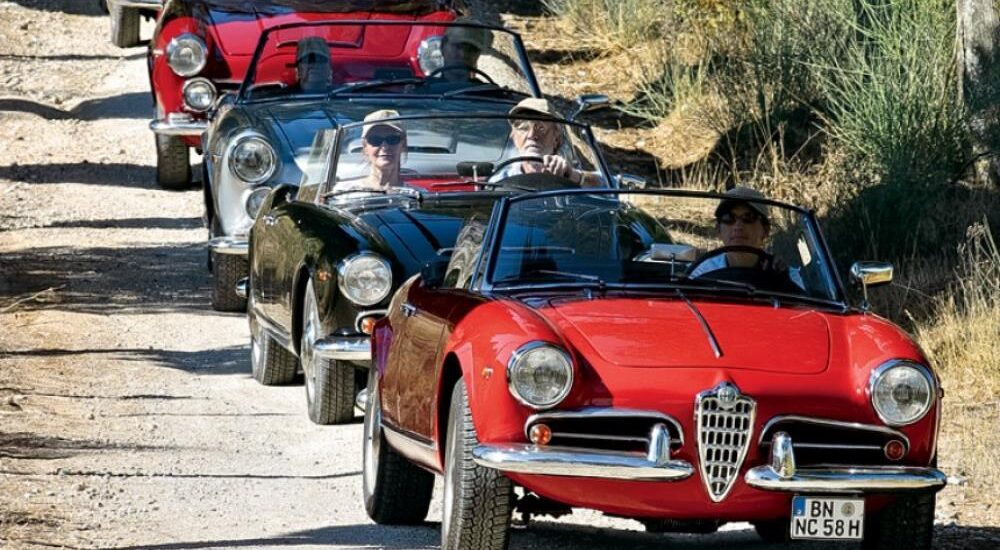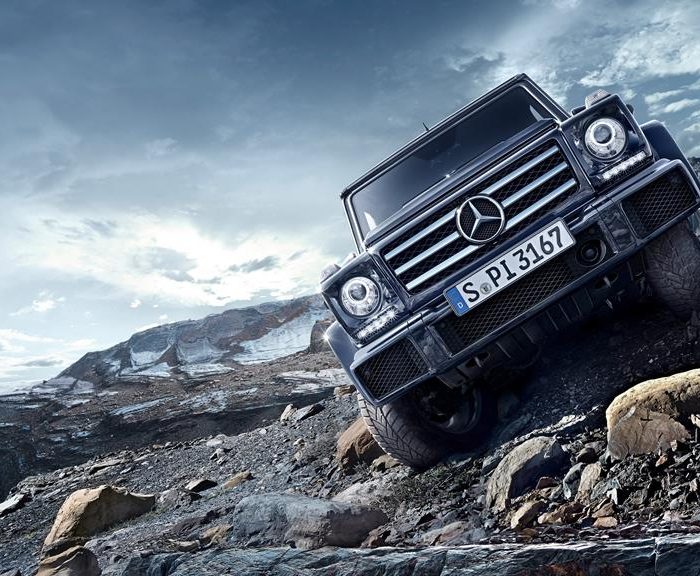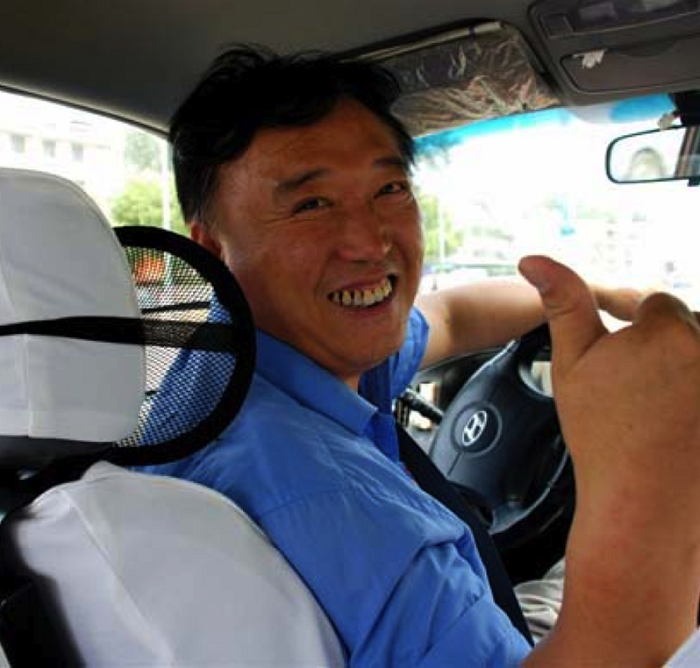Irren. Äh-rr! Irgendwie gelingt es dem Engländer Adam einfach nicht, im Alfa Romeo Giulietta Spider den zweiten Gang einzulegen. „Du sagst Doppelgriff?“ ruft er. “Irren. Äh-rr-rr-rr!” Ich sage ihm, dass das nicht funktionieren wird. Wie kann jemand mit so einem Getriebe fahren? Okay, Adam, es ist verzeihlich. Wurde Ihnen im wohlhabenden England beigebracht, wie man einen GAZ-52-Lkw mit nicht synchronisiertem Getriebe fährt? Lass mich das machen.
Die vom deutschen Privatunternehmen Nostalgic Tours organisierte Veranstaltung ähnelt stark einer regulären Probefahrt eines Automobiljournalisten. Sie fliegen nach Italien, werden in Autos eingeteilt, erhalten ein Roadbook, das eine Legende der bevorstehenden Route enthält, und schon geht es los durch die Straßen der Toskana. Dann Abendessen, eine Nacht in einem guten Hotel und ein weiterer fast ganzer Tag mit dem Auto. Der einzige Unterschied besteht darin, dass die Autos nicht neu sind; Sie sind alt: Alfa Romeo Spider aus den 50er, 60er und 70er Jahren. Und die Marke Alfa Romeo selbst hat keinen direkten Bezug zu „Nostalgie-Touren“ – ein paar deutsche Alfisti, Liebhaber alter Alfas, beschlossen, ihre Leidenschaft mit der Welt zu teilen und machten daraus ein kleines Unternehmen. Sie kauften etwa zwanzig Retro-Autos ihrer Lieblingsmarke, engagierten einen ehemaligen italienischen Rennmechaniker mit der Wartung und bieten „Nostalgie-Touren“ für etwa 2500 Euro pro Person an.
Für mich hat diese Tour eine ganz andere Bedeutung: Wenn ein Sowjetmensch nostalgisch werden kann, dann wahrscheinlich nur für die buckligen Saporoschez, die VAZ-„Kopejka“ oder den „Gazon“, dessen Getriebe ich kaputt gemacht habe, während ich ein paar farbenfrohe Sprachstunden von ihnen erhalten habe Mentor im Autowerk Nr. 1. Alfa Romeo Giulietta, Giulia oder Spider waren nichts weiter als ein Traum, ein Traum, von dem man nur im DOSAAF-Magazin Behind the Wheel lesen konnte.
Und jetzt bin ich hier, zusammen mit dem Engländer Adam, und kann alle Autos aus dem Park von Nostalgic Tours ausprobieren. Und wenn wir der Chronologie folgen, sollten wir mit dem frühesten Alfa beginnen.
Also hieß es Giulietta…

Die Giulietta-Spinne von Battista „Pinin“ Farina. Italien, zweite Hälfte des 20. Jahrhunderts. Stahl, Chrombeschichtung, Glas, Gummi und etwas Kunststoff.
Anfang der fünfziger Jahre, Italien erholt sich aus der Nachkriegskrise, Massentransportmittel: Fahrräder, Isetta-Motorroller, hergestellt in Lizenz von BMW. Die Pracht von Alfa Romeo aus der Vorkriegszeit lag in der Vergangenheit, als Achtzylinder-Schönheiten und siegreiche Rennwagen mit Geldern der faschistischen Regierung gebaut wurden. Der Krieg lag hinter ihnen – die Produktion von Flugzeugtriebwerken für italienische Jäger und Bomber, die völlige Zerstörung des Hauptwerks von Portello in Mailand, Versuche, Küchenherde in der verbleibenden südlichen Niederlassung in Pomigliano herzustellen. Aber die geschwindigkeitsverliebten Ingenieure verließen Alfa Romeo nicht – der Designer Orazio Satta, der Motorenbauer Giuseppe Busso, der Schöpfer der „Formel“ Alfa Romeo 158 aus der Vorkriegszeit, Giuseppe Colombo. Auch wenn sich das erste Nachkriegsmodell als Fehlschlag herausstellte – die Limousine Alfa Romeo 1900 war für das verarmte Italien zu groß und zu teuer. So gelang es Alfa Romeo auf jeden Fall, mit lautstarken Präsentationen und der Ankündigung einer landesweiten Lotterie (deren Gewinner nie die versprochenen 200 ersten Autos erhielten) Geld für ein kompakteres Massenmodell zu sammeln, das aufs Fließband gebracht wurde 1954 unter dem Namen Giulietta.
Manche sagen, dass der Name, der erste „persönliche“ für Alfa Romeo, von der Frau des berühmten italienischen Dichters der damaligen Zeit, Leonardo Sinisgalli, vorgeschlagen wurde. Andere erwähnen einen gewissen russischen Adligen, der Impresario in einem Mailänder Nachtclub war und scherzte, als sich Leute von Alfa Romeo vorstellten: „Sie haben hier acht Romeos und keine einzige Julia?“
Wie auch immer, Giulietta entpuppte sich als Schönheit. Sogar die Limousine war schön und viel attraktiver als ihr sowjetischer Zeitgenosse, der Moskwitsch-402. Und das Coupé von Bertone und der Spider von Farina…

Das Fahren mit offenem Verdeck macht auch bei heruntergelassenen Fenstern mehr Spaß – in der Kabine kann es etwas windig werden, aber es ist gleichmäßig und… ziemlich angenehm.

„Nur ein Vollidiot würde beim Fahren einer Giulietta von der Straße fliegen“, bemerkten Automobiljournalisten in den 1950er-Jahren.
Was ich am meisten fürchtete, war die Enge und die berüchtigte „italienische Fahrposition“, bei der die Beine die Lenksäule umschließen – das Kupplungs- und Bremspedal sowie das hängende Gaspedal. Der kompakte Sitz ist praktisch auf Bodenhöhe positioniert, sodass Sie mit ausgestreckten Beinen eine rennwagenähnliche Haltung einnehmen können. Um es ins rechte Licht zu rücken: Wenn man ihn mit einem Supersportwagen dieser Zeit vergleicht, wie dem Jaguar E-Type, in den ich mich kürzlich während der Rallye Monte-Carlo Historique „gequetscht“ habe, trumpft die Giulietta in puncto Ergonomie auf elegantes Pedalgefühl. Es ist, als ob die Giulietta Sie sanft mit einem anmutigen Fuß in einem stilvollen Schuh berührt. Im „E-Type“ sitzt man etwas gebeugt, während man sich hier halb zurücklehnt, was an das Faulenzen auf einer Chaiselongue erinnert. Es ist Dolce Vita, das süße Leben unter dem grenzenlosen Himmel des Apennin!
Aber gehen Sie vorsichtig vor: Keine Sicherheitsgurte, keine nennenswerten Sicherheitsfunktionen und die Nabe des Lenkrads ist direkt auf Ihre Brust gerichtet. Wenn Sie durch eine chaotische Kurve navigieren, fragen Sie sich vielleicht, ob der nächste Roller, der sich mit rasender Geschwindigkeit nähert, die linke Seite wählt.
Aber keine Angst; Solche Bedenken werden Sie bei einem Alfa nicht plagen. Dieses Auto wurde geboren, um nichts als Glück zu bringen!
Die schlanken Pedale liegen nah am Getriebetunnel – am Boden montierte Bremsen und Kupplung, ergänzt durch ein aufgehängtes Gaspedal. Beim Durchtreten des Gaspedals tut sich der 1300er-Motor zunächst schwer, nicht aus Gefühlen, sondern aus Luftüberfluss. Es scheint, dass das Rückschlagventil in der Beschleunigerpumpe Schwierigkeiten hat, alles zurückzuhalten.

Der Innenraum ist gemütlich, mit minimalem Feinschliff, aber wie gemütlich ist es, sich in der Giulietta-Giulia zurückzulehnen!

Und jetzt betreten wir eine Giulia von 1965: 1600 cm³, die ikonischen „Nasenlöcher“ auf der Motorhaube und ein Fünfganggetriebe.
Ah, wo sind meine Dreizehn und der weiße VAZ „kopeyka“ mit dem schwarzen Nummernschild 57-71 MTB? Damals, in den frühen 80ern, streichelte der Sound des „italienischen“ Motors die Ohren inmitten der basslastigen Moskauer Autos – und jetzt erkenne ich diese seidigen „VAZ“-Töne wieder. Klassisches Italien! Schließlich wurde die Architektur dieser „Vier“ schon vor dem Krieg vom legendären Vittorio Jano, dem Motorenbauer Lanzi und Ferrari entworfen. Aluminiumblock mit gusseisernen Laufbuchsen, fünffach gelagerte geschmiedete Kurbelwelle, halbkugelförmige Brennkammer, zwei „obere“ Nockenwellen, angetrieben durch eine zweireihige Kette, zentral positionierte Zündkerzen. In verschiedenen Varianten lief dieser Motor bis 1995 auf den Montagebändern der FIAT-Gruppe!
Wenn der Vergaser schließlich den Kraftstoff durch alle seine komplizierten Kanäle zieht und ein sanfter Zug entsteht, reicht es nicht: Der Motor hat nicht die Kraft für steile Steigungen und man muss schrittweise in den ersten Gang zurückschalten. Nikita Gudkov lobte das Giulietta-Coupé für seine Beschleunigungsdynamik, fuhr aber einen gepflegten Privatwagen. Die Autos von Nostalgic Tours gelten als Leihwagen, und es ist unwahrscheinlich, dass die meisten Fahrer wissen, wie man mit empfindlicher Retro-Technologie richtig umgeht.

Ein kleiner Kofferraum, Bodenpedale für Kupplung und Bremse sowie eine Abziehstange für die Handbremse.
Giulietta war nicht nur für ihr Design bekannt, sondern auch für ihr Handling! Der damalige in Moskau hergestellte Moskwitsch-402 hatte einen 35-PS-Motor aus Gusseisen mit niedrigerem Ventil, nur drei Gänge mit Hebelschaltung unter dem Lenkrad und eine Hinterachse mit Blattfedern – und sogar das Modell Moskwitsch von 1958 -407-Motor, bereits mit hängenden Ventilen, einem Aluminiumkopf und auf 1360 ccm aufgebohrt, leistete nur 45 PS. Während der Motor der einfachsten Giulietta-Limousine 53 PS leistete, multipliziert mit vier „kurzen“ Gängen, wurde im Coupé und Spider derselbe 1300-cm³-Motor auf 81 PS gesteigert! Außerdem gab es die leichtere und getunte Giulietta Veloce, „Fast“: 90 PS und minus 75 kg Leergewicht…
Das dünne Lenkrad aus schwarzem „knochenähnlichem“ Kunststoff fühlt sich zunächst leicht an, doch sobald man es dreht, spüren die Hände sein Gewicht: Die Front des Autos bewegt sich sofort zur Seite und überwindet seine mangelnde Manövrierfähigkeit. Aber in einem Moment passt sich Giulietta an, das Lenkrad „hellt“ … Das liegt an der schon vor dem Krieg vorhandenen Einzelradaufhängung „rundum“ von Lancia, und Horacio Satta und Kollegen entschieden sich für eine günstigere Variante: eine ungeteilte Hinterachse. Allerdings ist es an Federn aufgehängt und zusätzlich über einen dritten zentralen A-förmigen Hebel mit der Karosserie verbunden. Doch selbst die roten Koni-Classic-Stoßdämpfer in Kombination mit 15-Zoll-Uniroyal-Radialreifen gleichen die kinematischen Mängel nicht aus. Daher müssen schnelle Kurven in der Giulietta mit einer „suchenden Lenkung“ bewältigt werden, die zwischen unzureichender und übermäßiger Manövrierfähigkeit balanciert.

Die Flaggschiff-Spider Alfa Romeo 2600 wurden von der Mailänder Carrozzeria Touring hergestellt: Sie waren leistungsstärker, aber anderthalbmal schwerer als die Giulietta und viel teurer.
Und was ist mit dem Getriebe? Hochfahren – nur mit Doppelkupplung, und bergab – mit einem Zwischenbetätigung in den Leerlauf, um die Primärwelle hochzudrehen. Tatsächlich waren die Getriebe der Giulietta Roadster voll synchronisiert, was damals ein Luxus war. Darüber hinaus kauften die Italiener eine Lizenz für Synchronisierungen von Porsche. Aber dieses spezielle Auto scheint ziemlich abgenutzt zu sein – die Karosserie glänzt mit frischem Lack, Chrom glänzt in der italienischen Sonne, aber die Synchronisierungen sind „tot“. Äh-rr-rr-rr, äh-rr-rr! Der Engländer Adam füllte die toskanischen Hügel nur mit einem fürchterlichen Knirschen der Gänge und verlor an Schwung, da er nach dem dritten oder vierten nicht in der Lage war, den zweiten Gang einzulegen.
Egal, was jemand sagt, ich bleibe bei Suworows Grundsatz: „Schwer im Training, leicht im Kampf!“ Ich habe in meiner Jugend gelernt, auf „Baumstämmen“ zu fahren – ich bin alles gefahren, was Kolben hatte, unabhängig von der Anwesenheit von Bremsen oder dem Spiel im Lenkrad – wenn man das fahren kann, kann man alles fahren!

Der Innenraum ist geräumiger und reichhaltiger, aber die „+ zwei“-Sitze hinten sind nutzlos, die Sitzgelegenheiten sind nicht so gemütlich wie in der Giulia und das Lenkrad ist viel schwerer.
Eine Mittagspause – eine Chance, auf die Giulia umzusteigen. Es war ein Generationswechsel, doch während sich die Giulia-Limousinen deutlich von den Giuliettas unterschieden, wurden die Coupés und Roadster geringfügig modernisiert. Darüber hinaus war es ein schrittweiser Prozess (erinnern Sie sich an den Übergang vom VAZ „zehn“ zum Prioras?). Die Umwandlung der Giulietta in die Giulia begann 1959 mit einem längeren Radstand und wurde 1965 abgeschlossen, als für einen größeren 1600-cm³-Motor zusätzliche Nasenlöcher am Lufteinlass erforderlich waren. Eine fragwürdige Zierde, aber 90 PS – das macht jetzt mehr Spaß! Und das Getriebe in diesem Auto war in einwandfreiem Zustand – die Gänge ließen sich problemlos, leicht und präzise schalten. Aber die Bremsen! Es gab einfach keine Bremsen vorne; nur die hinteren funktionierten. Etwas fester gedrückt – und ein Rutschen! Es war dieses Auto, das später in einen Unfall mit der Frau eines niederländischen Geschäftsmanns und Verlegers verwickelt wurde: Sie bremste vor einer Kurve zu stark – und der schöne Alfa drehte sich sofort und prallte mit dem Kofferraum gegen eine Barriere. Zum Glück nicht zu ernst.
Aber für solche Fälle folgt dem Konvoi ein Evakuierungswagen mit einem Ersatzwagen – und auch ich musste dessen Dienste in Anspruch nehmen. Ich fahre ein Alfa Romeo 2600 Cabrio – und plötzlich…


Eine Reihe von zwei obenliegenden Nockenwellen treibt den Sechszylindermotor an: 145 PS, ausgestattet mit drei Solex-Vergasern, aber … der Funke scheint verschwunden zu sein.
Dieses Auto ist ein klarer Beweis dafür, dass „teurer“ nicht unbedingt „besser“ bedeutet. Dieses Modell hatte keinen eigenen Namen – der Index 2600 spiegelte den Hubraum des Reihensechszylinders wider, der zum ersten Mal seit der Vorkriegszeit endlich wieder unter die Haube der Straßenautos von Alfa zurückkehrte. Die Limousine Alfa 2600 ersetzte 1961 das bisherige Flaggschiff Alfa Romeo 2000, und die darauf basierenden Coupés und Roadster wurden von Giugiaro bzw. Carrozzeria Touring entworfen. Sie versuchten, das Design im Giulietta-Stil beizubehalten, und…
Nun, natürlich ist es wunderschön. Aber es gibt nicht mehr dieses organische Gefühl. Sechs Zylinder klingen weicher und kultivierter als die vier in der Giulietta, und die Federung ist komfortabler – während die Giulietta mit ihrer leichten Karosserie (die jedoch solide und monolithisch bleibt) auf schlechter Straße ständig ruckelt, fährt sich der Alfa 2600 spürbar ruhiger . Aber das Auto ist schwerer und beschleunigt langsamer. Und die Lenkung ist in Kurven schwergängig – schwer zu steuern! Ausgeprägtes Untersteuern.

So ausgeprägt, dass man überhaupt keine Lust mehr hat, schnell zu fahren. Einfach gemütlich kreuzen und die toskanische Schönheit bewundern. An diesen spärlich bewaldeten Hügeln, an den Reihen von Wächterzypressen, die die geraden, mit frischem weißem Kies bedeckten Wege säumen, an den endlosen Weinbergen …
Und natürlich ein Cabriolet – es ist eine ganz andere Ebene der Verbindung mit der Welt um uns herum. Vor allem ein altes Cabrio. Wenn sich Windgeräusche und Vogelgezwitscher mit dem kehligen Grollen des Vergasermotors vermischen und sich der bittere Geruch „unreiner“ Abgase mit den Aromen des gesegneten toskanischen Bodens vermischt …
Und der Wind in deinem Gesicht, tatsächlich.
Doch plötzlich – „tr-rrrr“: Der Motor verlor die Leistung und ging aus. Als hätte jemand es ausgeschaltet. Mit dem Anlasser zur Seite gerollt, Motorhaube angehoben… Ah, ich habe meine Fähigkeiten verloren. Früher hätte ich ohne zu zögern den Kraftstoffstand in der Schwimmerkammer überprüft oder das Hochspannungskabel herausgezogen, um den Funken zu sehen. Aber es ist schon eine Weile her, seit ich einen Schraubenschlüssel in der Hand hatte, und Alfa ist kein Zaporozhets. Also traf 15 Minuten nach dem Anruf der Miteigentümer von Nostalgic Tours, Gert Pichler, mit seiner Kollegin, der hübschen Russin Alena Bychikhina, ein und sie luden den „toten“ Alfa 2600 auf den Evakuierungswagen, und im Gegenzug Adam und Ich habe einen Alfa Romeo Spider.

Die Tachonadel zeigt streng nach unten… nicht still, sondern bei 40 km/h!

Die Sitze sind hier bequemer als in der Giulietta, allerdings ist der Schalthebel etwas zu „horizontal“.
Er löste 1966 die Giulia ab – sein stromlinienförmiges Tiefbaudesign erinnerte an den Jaguar E-Type. Aber die Technik war viel einfacher: immer noch eine starre Hinterachse und eine Lenkung vom Typ „Schnecke und Rollenmutter“. Der ursprüngliche Name „Duetto“, der im Rahmen eines landesweiten Wettbewerbs gefunden wurde, konnte sich nicht wirklich durchsetzen – ab Mitte der 70er Jahre hieß er einfach „Spider“. Und ich fahre ein Auto der zweiten Generation aus den frühen 70er-Jahren, bereits mit dem verkürzten Heck und einem 133 PS starken 2-Liter-Motor.
Der Innenraum besteht aus schwarzem Kunststoff und die Instrumentenanzeigen zeigen nach unten, genau wie bei modernen Alfas. Die Leistungsentfaltung ist fröhlich und gleichmäßig, wenn auch mit den typischen Vergaser-Zögern. Die Bremsen sind modern mit Vakuum-Bremskraftverstärker: Das Pedal ist leichtgängig, das Auto macht nirgendwo einen Ausfall… Aber das Handling liegt immer noch auf 90er-Jahre-Niveau: Die Reaktionen im Nah-Null-Bereich sind träge, dann lädt das Lenkrad plötzlich mit Kraftaufwand auf und das Ansprechverhalten nimmt zu. Außerdem gibt es „Gummi“-Reaktionen – die Reifen sind Vollprofil, direkt aus den 60er Jahren.
Und Sie spüren die Straße deutlicher als in modernen Autos. Selbst auf glattem Asphalt spürt man ständig leichte Vibrationen, und sobald man auf eine unbefestigte Straße abbiegt, beginnt die Kabine zu klappern und es ist ein spürbares Spiel im Lenkrad zu spüren.
Aber der damalige Spider war alles andere als ein Supersportwagen – genau wie die Giulietta-Giulia. Heutzutage wird diese Nische von Autos wie dem Audi TT oder dem BMW Z4 besetzt – teure Autos, die aber dennoch nicht nur für Millionäre zugänglich sind. Schauspielerinnen und Künstler, Anwälte und Zahnärzte kauften sie … Und das Leben genossen.
Das ist es, was die Veranstalter von „Nostalgie-Touren“ verkaufen – die Möglichkeit, so zu sein wie die erfolgreiche „Mittelschicht“ von vor einem halben Jahrhundert. Und der Authentizität halber organisieren sie Abendessen in einem Schlossmuseum, wo die Besitzer die Gäste persönlich begrüßen und über Jahrhunderte gesammelte Familiengemälde, Möbel, Geschirr, Kleidung oder Porzellanpuppen ausstellen. Oder in einem kleinen Familienrestaurant, wo ein riesiger Teller hausgemachte Pasta, großzügig bestreut mit den feinsten Trüffeln aus den heimischen Wäldern, gerade einmal zehn Euro kostet. Vierhundert Rubel in unserer Währung, und es ist so köstlich, dass Sie bereit sind, Ihre eigene Zunge zu schlucken.


Erkennen Sie diese runden Zusatzanzeigen und runden Armaturenbrett-Defroster? Die sind von FIAT.
Kurz gesagt: Italien.
Und hier…
An der Wende der 50er und 60er Jahre konnte mein Vater, wenn er von einem Cabriolet träumen konnte, nur von der „Ziege“ GAZ-69 träumen. Aber er fuhr damals einen GAZ-51-Lastwagen – als sie, Studenten des Uraler Bergbauinstituts, 1956 geschickt wurden, um die berühmte „Goldene Milliarde“ zu ernten, eine unerwartet reiche Weizenernte aus den kürzlich gepflügten kasachischen Steppen. Das Getreide verrottete, es wurde in nahegelegene Sümpfe geworfen, es gab nicht genügend Menschen, Maschinen, Aufzüge oder Waggons. Und die nach Kasachstan gebrachten Studenten hatten nichts zu essen, also schickten sie meinen Vater nach Hause nach Swerdlowsk, um ein Gewehr zu holen. Er und ein Freund fuhren kostenlos auf dem Dach von Eisenbahnwaggons, genossen den Wind in ihren Gesichtern, brachten eine 16-Gauge-„Tulka“ zum Bahnhof Mamlyutka zurück und versuchten, vorbeikommende Enten zu erschießen, um etwas Fleisch zu bekommen …
Leider hatten wir weder Roadster noch Spider, wir hatten kein leichtes Leben. Unsere Nostalgie für Alfas ist eingebildet. Wie eine Scheinschwangerschaft oder Phantomschmerzen. Wir hatten Belka und Strelka, wir hatten Sputnik und Gagarin, wir hatten Tu-22 und BTR-60. Und wir hatten die Pobeda und die Wolga, die „Emka“ und die „Anderthalb“…
Ich bin sie auch gefahren. Natürlich nicht in Italien – in Nischni Nowgorod, beim Gorkyclassic GAZ-Jubiläumsfestival. Ich erzähle dir nächstes Mal mehr.

Alfa Romeo Duetto, auch Spider genannt: 27 Jahre am Fließband, von 1966 bis 1993! Dabei handelt es sich um ein Auto der zweiten Generation, einen 2000 Veloce aus dem Jahr 1970 – mit „abgeschnittenem“ Kofferraum und einem 133 PS starken 2-Liter-Motor.
Foto: Nostalgic Tours Company | Leonid Golowanow
Dies ist eine Übersetzung. Den Originalartikel können Sie hier lesen: Леонид Голованов поездил на старых Alfa Romeo из коллекции Nostalgic Tours

Veröffentlicht August 30, 2023 • 15 m zum Lesen





